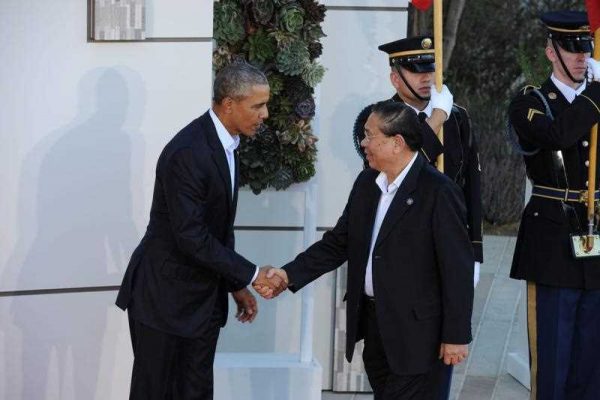The first high-level US engagement with Laos this year took place in California on 15–16 February when Obama and Lao Prime Minister Thongsing Thammavong jointly chaired a summit discussion between Southeast Asian and US leaders.
US Secretary of State John Kerry visited Laos on 25 January to hammer out the summit’s format and agenda. Kerry landed just days after the Lao People’s Revolutionary Party completed its congress, which is held every five years to select the party’s leadership and set political and economic development goals. Laos’ foreign policy direction is one area that could see some of the most noticeable shifts in the months and years ahead.
Vietnamese communist forces helped their Lao counterparts seize power in 1975 and Hanoi has since retained significant influence in Vientiane. But in recent years, Laos had drifted closer to China as Beijing has stepped up its aid and investment in the country.
The Party Congress removed Choummaly Sayasone as the party chief and replaced him with current Vice President Bounnhang Vorachith. Deputy Prime Minister Somsavat Lengsavad was also removed. Like Choummaly, Somsavat had been instrumental in granting large economic concessions to Chinese companies over the past decade.
These decisions have been widely interpreted in Vientiane as an effort by party leaders to balance the regime’s foreign policy evenly between China and Vietnam, rather than tilting so firmly toward Beijing. There has been a palpable anxiety within the public, as well as among party members, that the ousted leaders had made Laos too dependent on China. Chinese companies, many of which are state-owned, have dramatically ramped up their economic footprint in the northern part of Laos.
Chinese companies have at least half a dozen mega real-estate projects in Vientiane, including shopping complexes and hotels. Chinese companies also hold a wide swath of mining and agriculture projects across much of northern Laos. In December 2015, the two countries agreed to start work on a US$6 billion railroad project linking southern China to Bangkok through Laos, which many economists believe will have minimal benefits for Laos.
The expected appointment of Deputy Prime Minister Thongloun Sisoulith to prime minister in March will help bolster Vientiane’s regional integration efforts. Thongloun has served as foreign minister since 2006 and is viewed as somewhat of an internationalist who wants to promote closer ties not only with Laos’ ASEAN neighbours, but also with the United States and Japan. Thongloun is not anti-China but wants to hedge Laos’ foreign policy with broader regional and international ties.
Thongloun recognises that with Laos chairing ASEAN this year, Vientiane will have to represent the interests of its Southeast Asian neighbours — some of which, like the Philippines and Vietnam, are facing increasing pressure from China in the disputed South China Sea. Lao officials have promised that there will not be a repetition of the power plays that occurred during Cambodia’s chairmanship in 2012, when Phnom Penh blocked a consensus ASEAN statement on the South China Sea at the apparent behest of Beijing.
Kerry told journalists that current Prime Minister Thongsing Thammavong ‘was very clear that he wants a unified ASEAN and he wants maritime rights protected, and he wants to avoid militarization and avoid the conflict’. Lao officials will likely try to operate on the principles of ASEAN centrality and consensus.
US–Lao relations have warmed in recent years as part of the United States’ larger rebalance to Asia. Kerry said the United States is launching a US$6 million nutrition program and touted a US funded ‘smart infrastructure’ project in Laos under the Lower Mekong Initiative to ease silting and facilitate fish migration. Kerry also raised ongoing human rights issues, including the forced disappearance three years ago of the well-known agronomist Sombath Somphone.
Still, much remains to be done to boost US ties with Laos in this pivotal year.
The Lao economy is forecast to expand by 7.7 per cent in 2016, making Laos the second fastest growing economy in Asia according to the Economist Intelligence Unit. Much of this growth is driven by natural resource extraction, the export of hydropower to Thailand and, more recently, tourism. But US trade and investment with Laos remains minimal.
Although US military ties with both China and Vietnam have grown over the past decade, relations with the Lao military are negligible. The Lao military has agreed to work with Washington on some English-language training for its soldiers but has not accepted the offer to send officers to US staff colleges.
The US government has run an education program in Laos for a number of years but Vientiane has suggested to the Obama administration that it is interested in a larger professional training program. Laos faces a serious shortage of knowledgeable technocrats and skilled labour, a factor that has held back economic development.
Laos has increasingly been on the Asia travel itinerary of senior US officials. But, beyond the visits by the Lao health minister in 2014 and Deputy Prime Minister Thongloun two years before that, few senior Lao officials have been exposed to the United States. Once the new government takes office in Vientiane, the US government should invite more senior Lao officials to visit Washington to bolster trust between the two countries.
Murray Hiebert is senior fellow and deputy director of the Chair for Southeast Asia Studies at the Center for Strategic and International Studies in Washington, DC.
This article first appeared on the CSIS Asia Policy Blog, CogitAsia, here. Reposted with permission.


We shall see what kind of statement comes out of the ASEAN meeting later today. I hope Mr. Hiebert will write another column on it.
I think we (the Hmong) who suffered from genocide in the jungle, who were killed like animals, they killed our children, the Lao government must bring those who killed our innocence people to justice. They can’t just let it go without cost.
So who’s the current labour minister of Laos?